Effective Communication in Organizations: An Essay Analysis
VerifiedAdded on 2022/10/04
|7
|1589
|316
Essay
AI Summary
This essay delves into the multifaceted nature of communication within organizations, emphasizing the critical roles of non-verbal communication, active listening, and feedback mechanisms. It begins by establishing the fundamental importance of communication in exchanging ideas and facilitating organizational processes, highlighting both verbal and non-verbal approaches. The essay then focuses on non-verbal communication, illustrating its significance through real-world examples such as airports and hospitals, where signboards convey essential information efficiently. Furthermore, the essay explores active listening, defining it as the active reception and interpretation of information, crucial for effective communication. Feedback, both productive and destructive, is analyzed for its impact on the communication process, emphasizing the positive effects of constructive feedback in fostering cooperation and enhancing skills. The essay concludes by underscoring the essentiality of communication, especially non-verbal methods, active listening, and feedback, in achieving effective organizational operations. It emphasizes that effective communication requires active listeners providing valuable feedback and that non-verbal cues, such as facial expressions and body language, enhance the communication process.
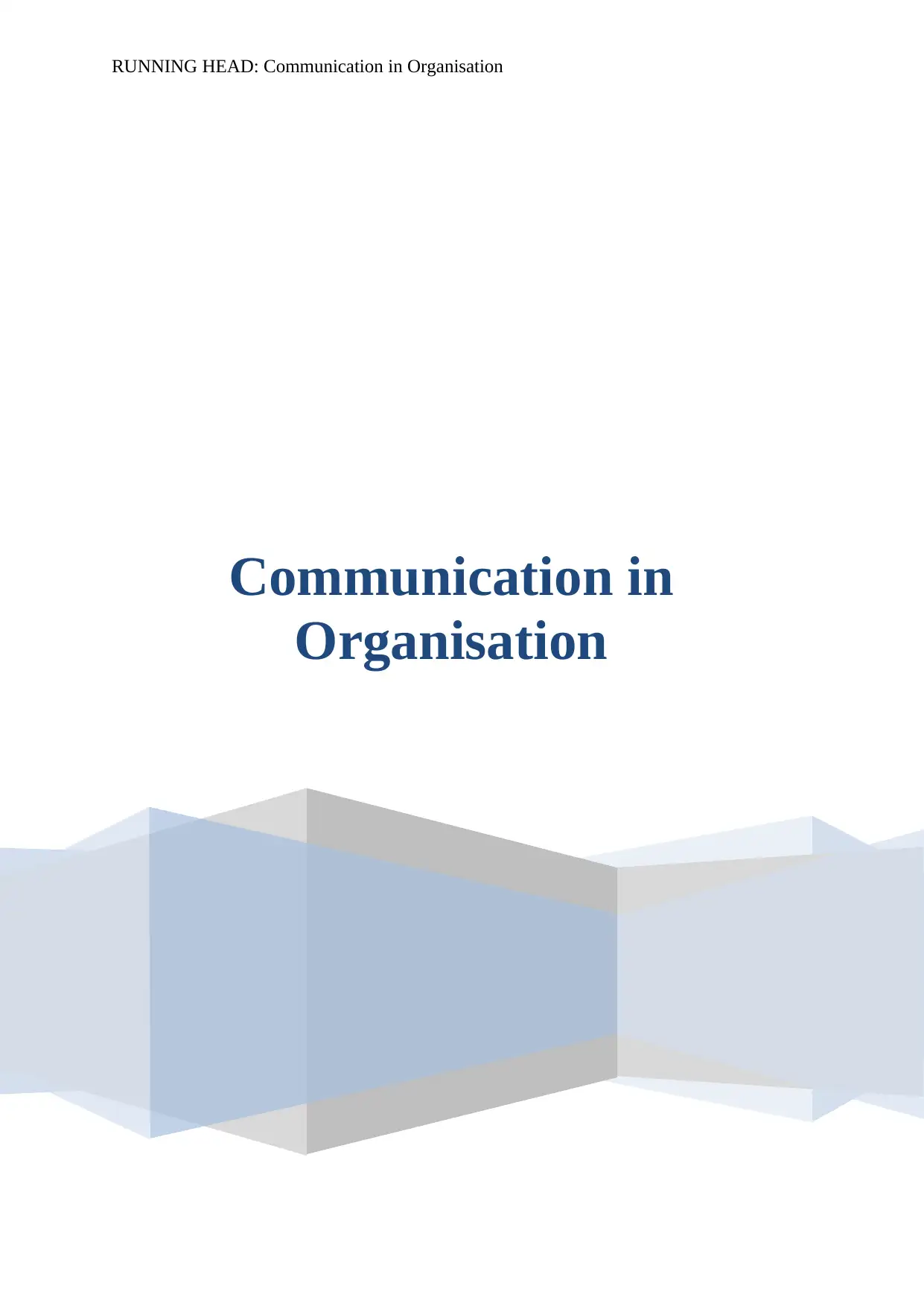
RUNNING HEAD: Communication in Organisation
Communication in
Organisation
Communication in
Organisation
Paraphrase This Document
Need a fresh take? Get an instant paraphrase of this document with our AI Paraphraser
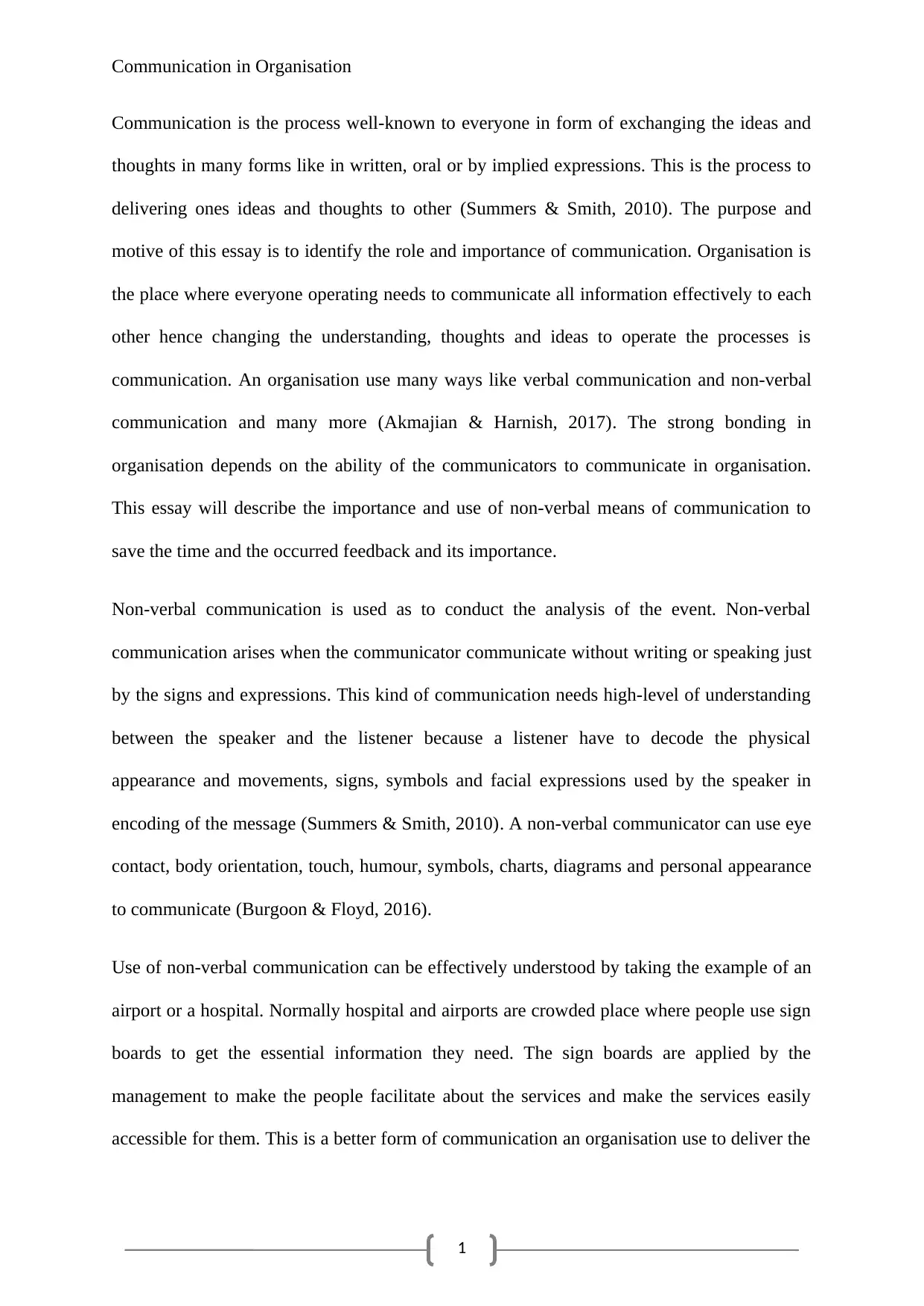
1
Communication in Organisation
Communication is the process well-known to everyone in form of exchanging the ideas and
thoughts in many forms like in written, oral or by implied expressions. This is the process to
delivering ones ideas and thoughts to other (Summers & Smith, 2010). The purpose and
motive of this essay is to identify the role and importance of communication. Organisation is
the place where everyone operating needs to communicate all information effectively to each
other hence changing the understanding, thoughts and ideas to operate the processes is
communication. An organisation use many ways like verbal communication and non-verbal
communication and many more (Akmajian & Harnish, 2017). The strong bonding in
organisation depends on the ability of the communicators to communicate in organisation.
This essay will describe the importance and use of non-verbal means of communication to
save the time and the occurred feedback and its importance.
Non-verbal communication is used as to conduct the analysis of the event. Non-verbal
communication arises when the communicator communicate without writing or speaking just
by the signs and expressions. This kind of communication needs high-level of understanding
between the speaker and the listener because a listener have to decode the physical
appearance and movements, signs, symbols and facial expressions used by the speaker in
encoding of the message (Summers & Smith, 2010). A non-verbal communicator can use eye
contact, body orientation, touch, humour, symbols, charts, diagrams and personal appearance
to communicate (Burgoon & Floyd, 2016).
Use of non-verbal communication can be effectively understood by taking the example of an
airport or a hospital. Normally hospital and airports are crowded place where people use sign
boards to get the essential information they need. The sign boards are applied by the
management to make the people facilitate about the services and make the services easily
accessible for them. This is a better form of communication an organisation use to deliver the
Communication in Organisation
Communication is the process well-known to everyone in form of exchanging the ideas and
thoughts in many forms like in written, oral or by implied expressions. This is the process to
delivering ones ideas and thoughts to other (Summers & Smith, 2010). The purpose and
motive of this essay is to identify the role and importance of communication. Organisation is
the place where everyone operating needs to communicate all information effectively to each
other hence changing the understanding, thoughts and ideas to operate the processes is
communication. An organisation use many ways like verbal communication and non-verbal
communication and many more (Akmajian & Harnish, 2017). The strong bonding in
organisation depends on the ability of the communicators to communicate in organisation.
This essay will describe the importance and use of non-verbal means of communication to
save the time and the occurred feedback and its importance.
Non-verbal communication is used as to conduct the analysis of the event. Non-verbal
communication arises when the communicator communicate without writing or speaking just
by the signs and expressions. This kind of communication needs high-level of understanding
between the speaker and the listener because a listener have to decode the physical
appearance and movements, signs, symbols and facial expressions used by the speaker in
encoding of the message (Summers & Smith, 2010). A non-verbal communicator can use eye
contact, body orientation, touch, humour, symbols, charts, diagrams and personal appearance
to communicate (Burgoon & Floyd, 2016).
Use of non-verbal communication can be effectively understood by taking the example of an
airport or a hospital. Normally hospital and airports are crowded place where people use sign
boards to get the essential information they need. The sign boards are applied by the
management to make the people facilitate about the services and make the services easily
accessible for them. This is a better form of communication an organisation use to deliver the
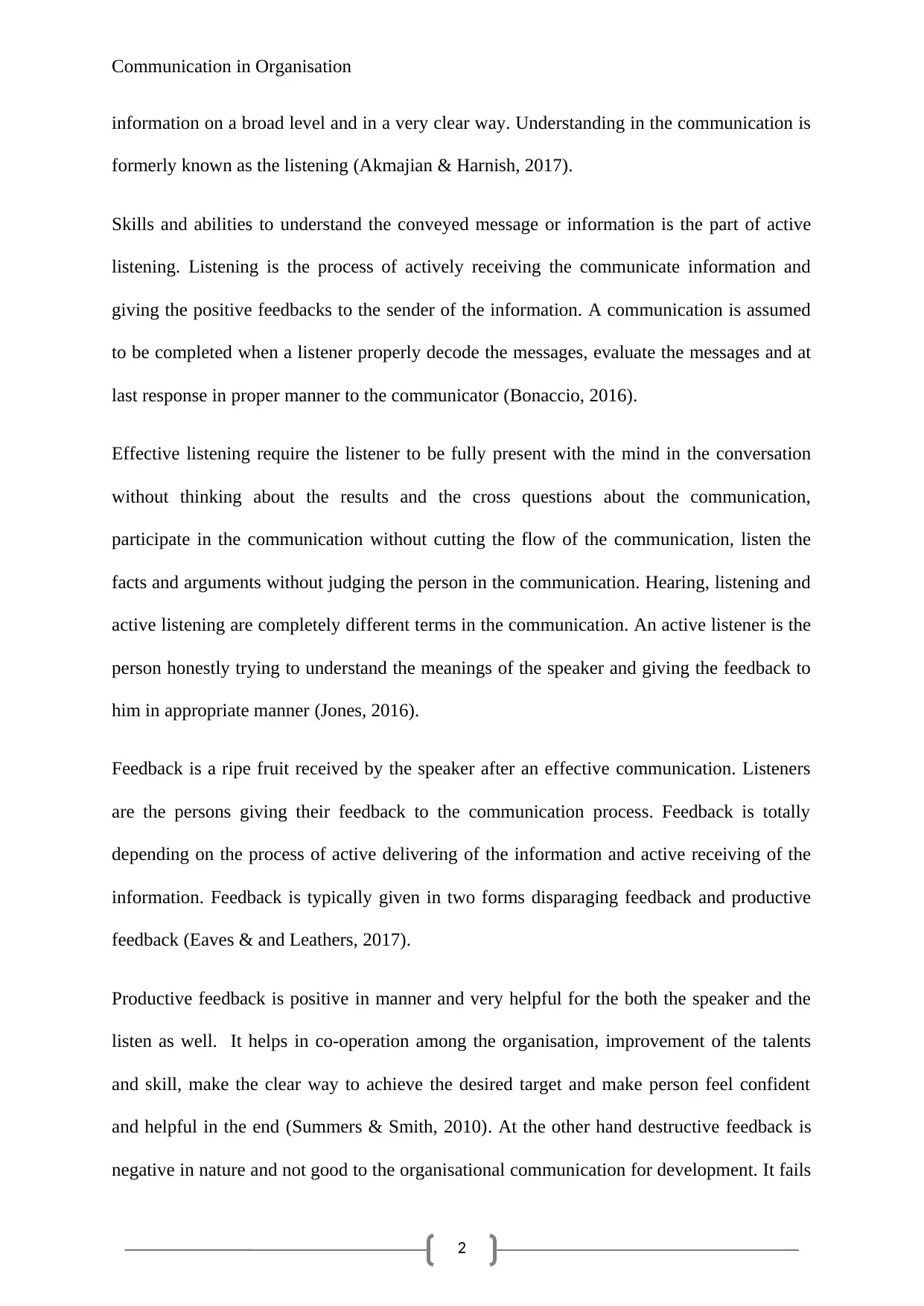
2
Communication in Organisation
information on a broad level and in a very clear way. Understanding in the communication is
formerly known as the listening (Akmajian & Harnish, 2017).
Skills and abilities to understand the conveyed message or information is the part of active
listening. Listening is the process of actively receiving the communicate information and
giving the positive feedbacks to the sender of the information. A communication is assumed
to be completed when a listener properly decode the messages, evaluate the messages and at
last response in proper manner to the communicator (Bonaccio, 2016).
Effective listening require the listener to be fully present with the mind in the conversation
without thinking about the results and the cross questions about the communication,
participate in the communication without cutting the flow of the communication, listen the
facts and arguments without judging the person in the communication. Hearing, listening and
active listening are completely different terms in the communication. An active listener is the
person honestly trying to understand the meanings of the speaker and giving the feedback to
him in appropriate manner (Jones, 2016).
Feedback is a ripe fruit received by the speaker after an effective communication. Listeners
are the persons giving their feedback to the communication process. Feedback is totally
depending on the process of active delivering of the information and active receiving of the
information. Feedback is typically given in two forms disparaging feedback and productive
feedback (Eaves & and Leathers, 2017).
Productive feedback is positive in manner and very helpful for the both the speaker and the
listen as well. It helps in co-operation among the organisation, improvement of the talents
and skill, make the clear way to achieve the desired target and make person feel confident
and helpful in the end (Summers & Smith, 2010). At the other hand destructive feedback is
negative in nature and not good to the organisational communication for development. It fails
Communication in Organisation
information on a broad level and in a very clear way. Understanding in the communication is
formerly known as the listening (Akmajian & Harnish, 2017).
Skills and abilities to understand the conveyed message or information is the part of active
listening. Listening is the process of actively receiving the communicate information and
giving the positive feedbacks to the sender of the information. A communication is assumed
to be completed when a listener properly decode the messages, evaluate the messages and at
last response in proper manner to the communicator (Bonaccio, 2016).
Effective listening require the listener to be fully present with the mind in the conversation
without thinking about the results and the cross questions about the communication,
participate in the communication without cutting the flow of the communication, listen the
facts and arguments without judging the person in the communication. Hearing, listening and
active listening are completely different terms in the communication. An active listener is the
person honestly trying to understand the meanings of the speaker and giving the feedback to
him in appropriate manner (Jones, 2016).
Feedback is a ripe fruit received by the speaker after an effective communication. Listeners
are the persons giving their feedback to the communication process. Feedback is totally
depending on the process of active delivering of the information and active receiving of the
information. Feedback is typically given in two forms disparaging feedback and productive
feedback (Eaves & and Leathers, 2017).
Productive feedback is positive in manner and very helpful for the both the speaker and the
listen as well. It helps in co-operation among the organisation, improvement of the talents
and skill, make the clear way to achieve the desired target and make person feel confident
and helpful in the end (Summers & Smith, 2010). At the other hand destructive feedback is
negative in nature and not good to the organisational communication for development. It fails
⊘ This is a preview!⊘
Do you want full access?
Subscribe today to unlock all pages.

Trusted by 1+ million students worldwide
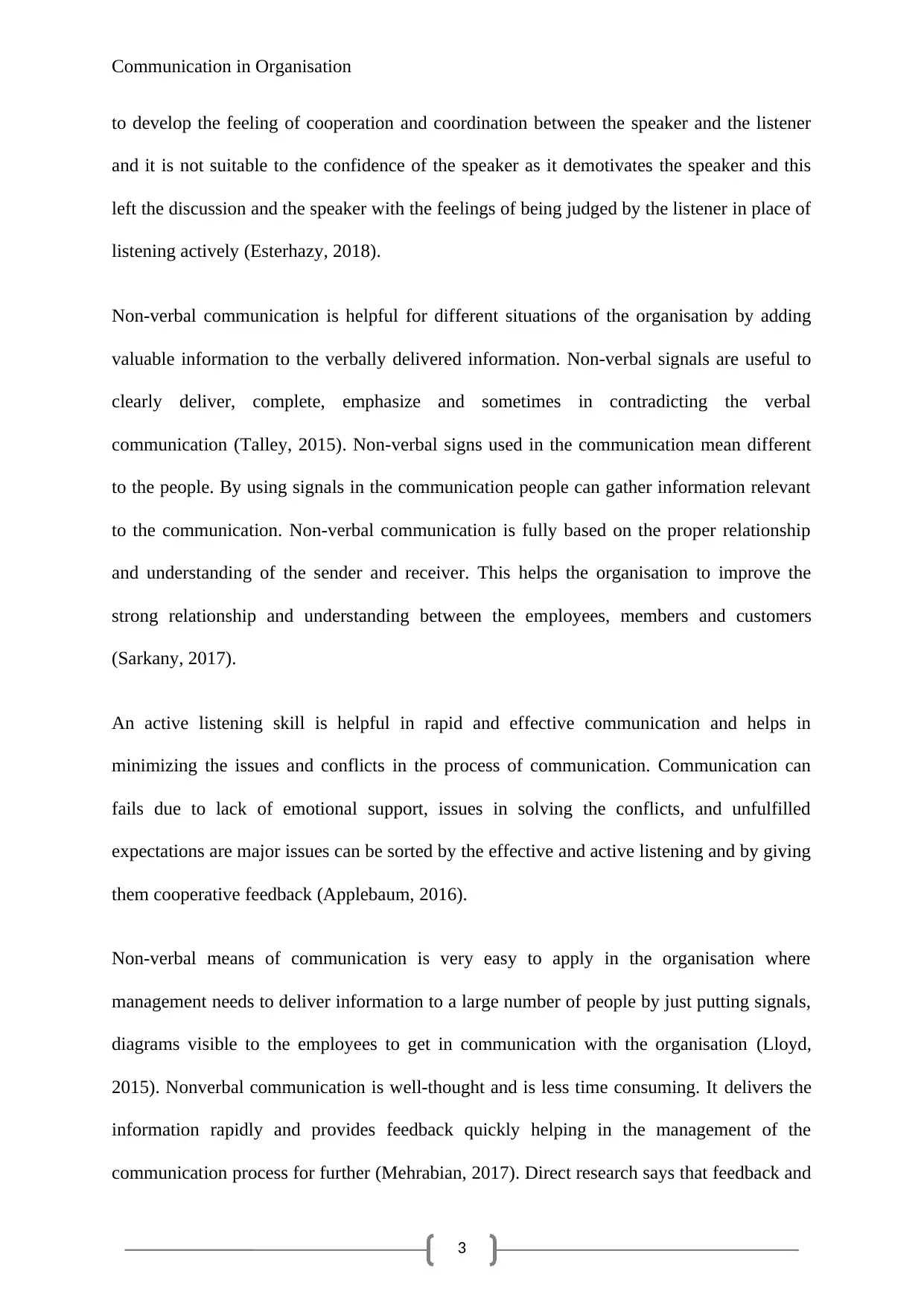
3
Communication in Organisation
to develop the feeling of cooperation and coordination between the speaker and the listener
and it is not suitable to the confidence of the speaker as it demotivates the speaker and this
left the discussion and the speaker with the feelings of being judged by the listener in place of
listening actively (Esterhazy, 2018).
Non-verbal communication is helpful for different situations of the organisation by adding
valuable information to the verbally delivered information. Non-verbal signals are useful to
clearly deliver, complete, emphasize and sometimes in contradicting the verbal
communication (Talley, 2015). Non-verbal signs used in the communication mean different
to the people. By using signals in the communication people can gather information relevant
to the communication. Non-verbal communication is fully based on the proper relationship
and understanding of the sender and receiver. This helps the organisation to improve the
strong relationship and understanding between the employees, members and customers
(Sarkany, 2017).
An active listening skill is helpful in rapid and effective communication and helps in
minimizing the issues and conflicts in the process of communication. Communication can
fails due to lack of emotional support, issues in solving the conflicts, and unfulfilled
expectations are major issues can be sorted by the effective and active listening and by giving
them cooperative feedback (Applebaum, 2016).
Non-verbal means of communication is very easy to apply in the organisation where
management needs to deliver information to a large number of people by just putting signals,
diagrams visible to the employees to get in communication with the organisation (Lloyd,
2015). Nonverbal communication is well-thought and is less time consuming. It delivers the
information rapidly and provides feedback quickly helping in the management of the
communication process for further (Mehrabian, 2017). Direct research says that feedback and
Communication in Organisation
to develop the feeling of cooperation and coordination between the speaker and the listener
and it is not suitable to the confidence of the speaker as it demotivates the speaker and this
left the discussion and the speaker with the feelings of being judged by the listener in place of
listening actively (Esterhazy, 2018).
Non-verbal communication is helpful for different situations of the organisation by adding
valuable information to the verbally delivered information. Non-verbal signals are useful to
clearly deliver, complete, emphasize and sometimes in contradicting the verbal
communication (Talley, 2015). Non-verbal signs used in the communication mean different
to the people. By using signals in the communication people can gather information relevant
to the communication. Non-verbal communication is fully based on the proper relationship
and understanding of the sender and receiver. This helps the organisation to improve the
strong relationship and understanding between the employees, members and customers
(Sarkany, 2017).
An active listening skill is helpful in rapid and effective communication and helps in
minimizing the issues and conflicts in the process of communication. Communication can
fails due to lack of emotional support, issues in solving the conflicts, and unfulfilled
expectations are major issues can be sorted by the effective and active listening and by giving
them cooperative feedback (Applebaum, 2016).
Non-verbal means of communication is very easy to apply in the organisation where
management needs to deliver information to a large number of people by just putting signals,
diagrams visible to the employees to get in communication with the organisation (Lloyd,
2015). Nonverbal communication is well-thought and is less time consuming. It delivers the
information rapidly and provides feedback quickly helping in the management of the
communication process for further (Mehrabian, 2017). Direct research says that feedback and
Paraphrase This Document
Need a fresh take? Get an instant paraphrase of this document with our AI Paraphraser
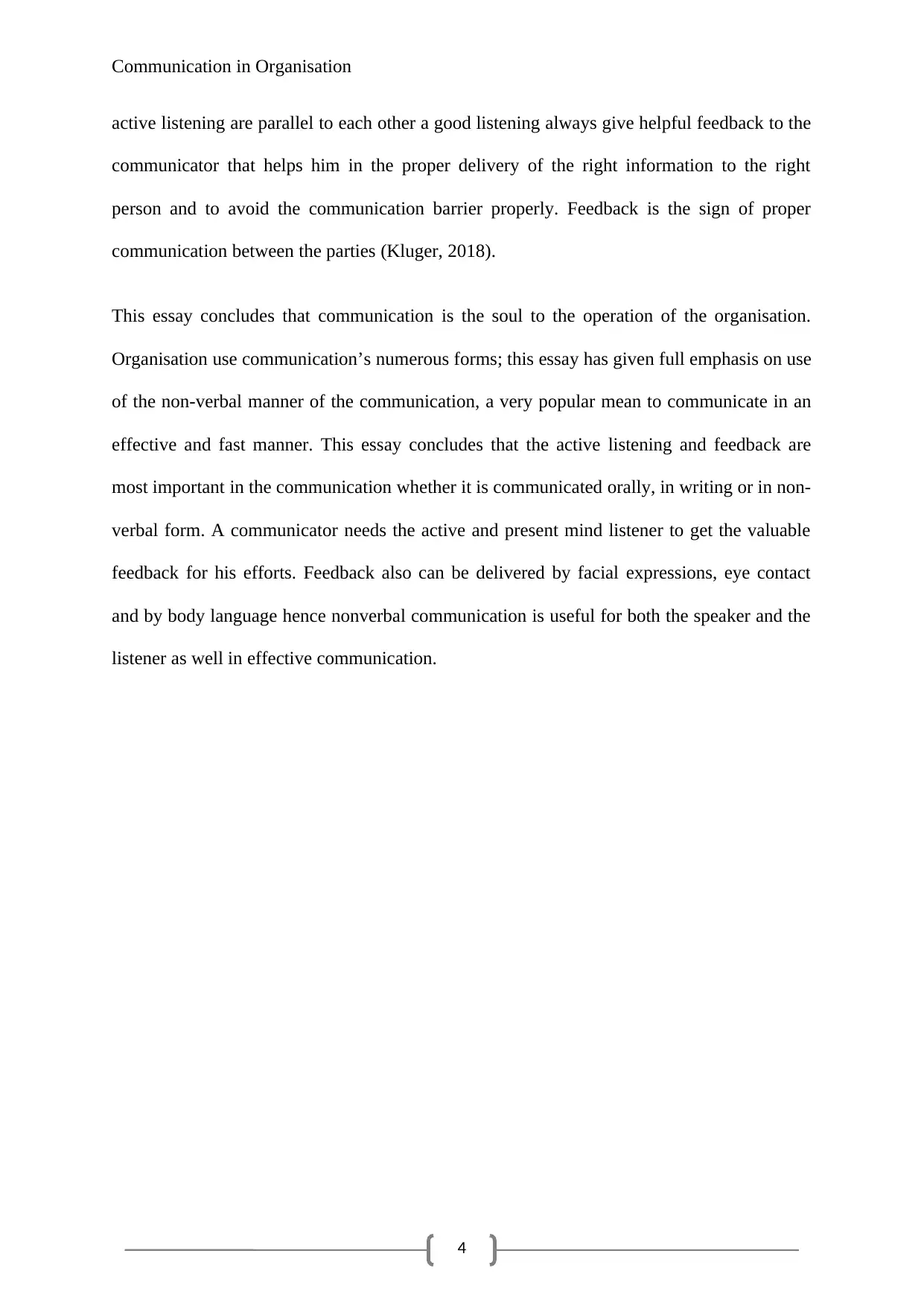
4
Communication in Organisation
active listening are parallel to each other a good listening always give helpful feedback to the
communicator that helps him in the proper delivery of the right information to the right
person and to avoid the communication barrier properly. Feedback is the sign of proper
communication between the parties (Kluger, 2018).
This essay concludes that communication is the soul to the operation of the organisation.
Organisation use communication’s numerous forms; this essay has given full emphasis on use
of the non-verbal manner of the communication, a very popular mean to communicate in an
effective and fast manner. This essay concludes that the active listening and feedback are
most important in the communication whether it is communicated orally, in writing or in non-
verbal form. A communicator needs the active and present mind listener to get the valuable
feedback for his efforts. Feedback also can be delivered by facial expressions, eye contact
and by body language hence nonverbal communication is useful for both the speaker and the
listener as well in effective communication.
Communication in Organisation
active listening are parallel to each other a good listening always give helpful feedback to the
communicator that helps him in the proper delivery of the right information to the right
person and to avoid the communication barrier properly. Feedback is the sign of proper
communication between the parties (Kluger, 2018).
This essay concludes that communication is the soul to the operation of the organisation.
Organisation use communication’s numerous forms; this essay has given full emphasis on use
of the non-verbal manner of the communication, a very popular mean to communicate in an
effective and fast manner. This essay concludes that the active listening and feedback are
most important in the communication whether it is communicated orally, in writing or in non-
verbal form. A communicator needs the active and present mind listener to get the valuable
feedback for his efforts. Feedback also can be delivered by facial expressions, eye contact
and by body language hence nonverbal communication is useful for both the speaker and the
listener as well in effective communication.
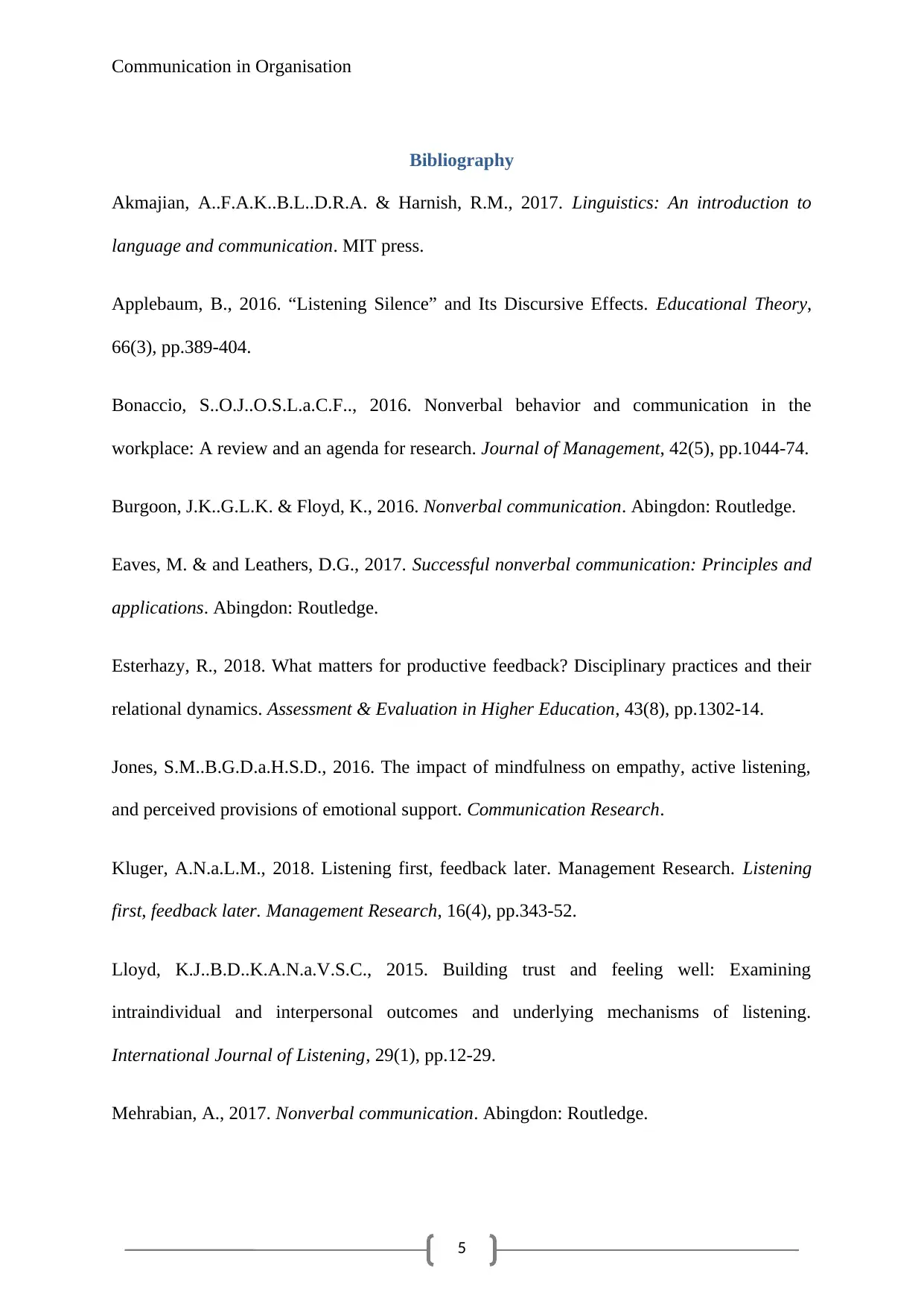
5
Communication in Organisation
Bibliography
Akmajian, A..F.A.K..B.L..D.R.A. & Harnish, R.M., 2017. Linguistics: An introduction to
language and communication. MIT press.
Applebaum, B., 2016. “Listening Silence” and Its Discursive Effects. Educational Theory,
66(3), pp.389-404.
Bonaccio, S..O.J..O.S.L.a.C.F.., 2016. Nonverbal behavior and communication in the
workplace: A review and an agenda for research. Journal of Management, 42(5), pp.1044-74.
Burgoon, J.K..G.L.K. & Floyd, K., 2016. Nonverbal communication. Abingdon: Routledge.
Eaves, M. & and Leathers, D.G., 2017. Successful nonverbal communication: Principles and
applications. Abingdon: Routledge.
Esterhazy, R., 2018. What matters for productive feedback? Disciplinary practices and their
relational dynamics. Assessment & Evaluation in Higher Education, 43(8), pp.1302-14.
Jones, S.M..B.G.D.a.H.S.D., 2016. The impact of mindfulness on empathy, active listening,
and perceived provisions of emotional support. Communication Research.
Kluger, A.N.a.L.M., 2018. Listening first, feedback later. Management Research. Listening
first, feedback later. Management Research, 16(4), pp.343-52.
Lloyd, K.J..B.D..K.A.N.a.V.S.C., 2015. Building trust and feeling well: Examining
intraindividual and interpersonal outcomes and underlying mechanisms of listening.
International Journal of Listening, 29(1), pp.12-29.
Mehrabian, A., 2017. Nonverbal communication. Abingdon: Routledge.
Communication in Organisation
Bibliography
Akmajian, A..F.A.K..B.L..D.R.A. & Harnish, R.M., 2017. Linguistics: An introduction to
language and communication. MIT press.
Applebaum, B., 2016. “Listening Silence” and Its Discursive Effects. Educational Theory,
66(3), pp.389-404.
Bonaccio, S..O.J..O.S.L.a.C.F.., 2016. Nonverbal behavior and communication in the
workplace: A review and an agenda for research. Journal of Management, 42(5), pp.1044-74.
Burgoon, J.K..G.L.K. & Floyd, K., 2016. Nonverbal communication. Abingdon: Routledge.
Eaves, M. & and Leathers, D.G., 2017. Successful nonverbal communication: Principles and
applications. Abingdon: Routledge.
Esterhazy, R., 2018. What matters for productive feedback? Disciplinary practices and their
relational dynamics. Assessment & Evaluation in Higher Education, 43(8), pp.1302-14.
Jones, S.M..B.G.D.a.H.S.D., 2016. The impact of mindfulness on empathy, active listening,
and perceived provisions of emotional support. Communication Research.
Kluger, A.N.a.L.M., 2018. Listening first, feedback later. Management Research. Listening
first, feedback later. Management Research, 16(4), pp.343-52.
Lloyd, K.J..B.D..K.A.N.a.V.S.C., 2015. Building trust and feeling well: Examining
intraindividual and interpersonal outcomes and underlying mechanisms of listening.
International Journal of Listening, 29(1), pp.12-29.
Mehrabian, A., 2017. Nonverbal communication. Abingdon: Routledge.
⊘ This is a preview!⊘
Do you want full access?
Subscribe today to unlock all pages.

Trusted by 1+ million students worldwide
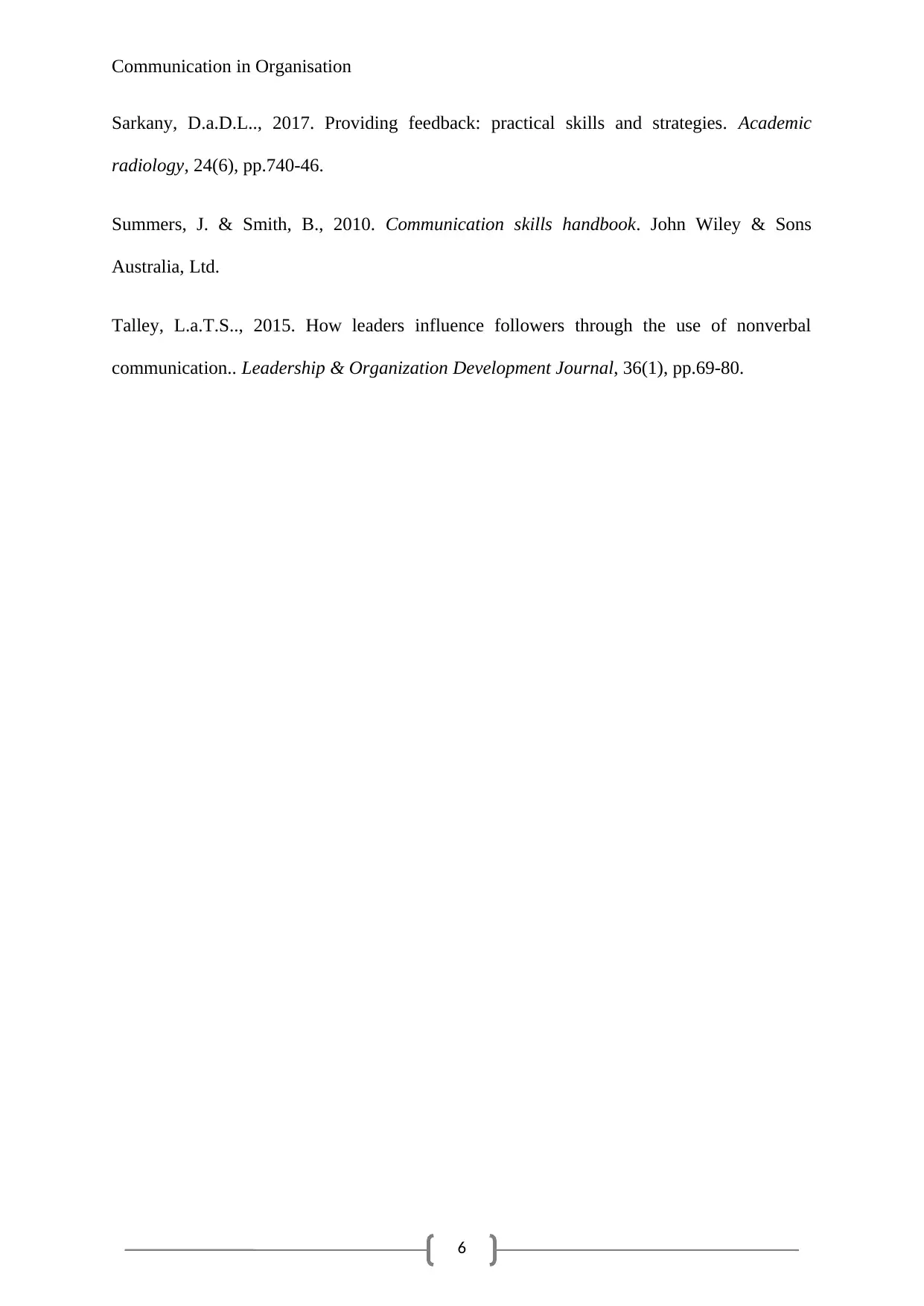
6
Communication in Organisation
Sarkany, D.a.D.L.., 2017. Providing feedback: practical skills and strategies. Academic
radiology, 24(6), pp.740-46.
Summers, J. & Smith, B., 2010. Communication skills handbook. John Wiley & Sons
Australia, Ltd.
Talley, L.a.T.S.., 2015. How leaders influence followers through the use of nonverbal
communication.. Leadership & Organization Development Journal, 36(1), pp.69-80.
Communication in Organisation
Sarkany, D.a.D.L.., 2017. Providing feedback: practical skills and strategies. Academic
radiology, 24(6), pp.740-46.
Summers, J. & Smith, B., 2010. Communication skills handbook. John Wiley & Sons
Australia, Ltd.
Talley, L.a.T.S.., 2015. How leaders influence followers through the use of nonverbal
communication.. Leadership & Organization Development Journal, 36(1), pp.69-80.
1 out of 7
Related Documents
Your All-in-One AI-Powered Toolkit for Academic Success.
+13062052269
info@desklib.com
Available 24*7 on WhatsApp / Email
![[object Object]](/_next/static/media/star-bottom.7253800d.svg)
Unlock your academic potential
Copyright © 2020–2025 A2Z Services. All Rights Reserved. Developed and managed by ZUCOL.

![Report on the Five Principles of Communication - [Semester]](/_next/image/?url=https%3A%2F%2Fdesklib.com%2Fmedia%2Fimages%2Fud%2F8e751cef51fb4146988a52d12f313ad6.jpg&w=256&q=75)


